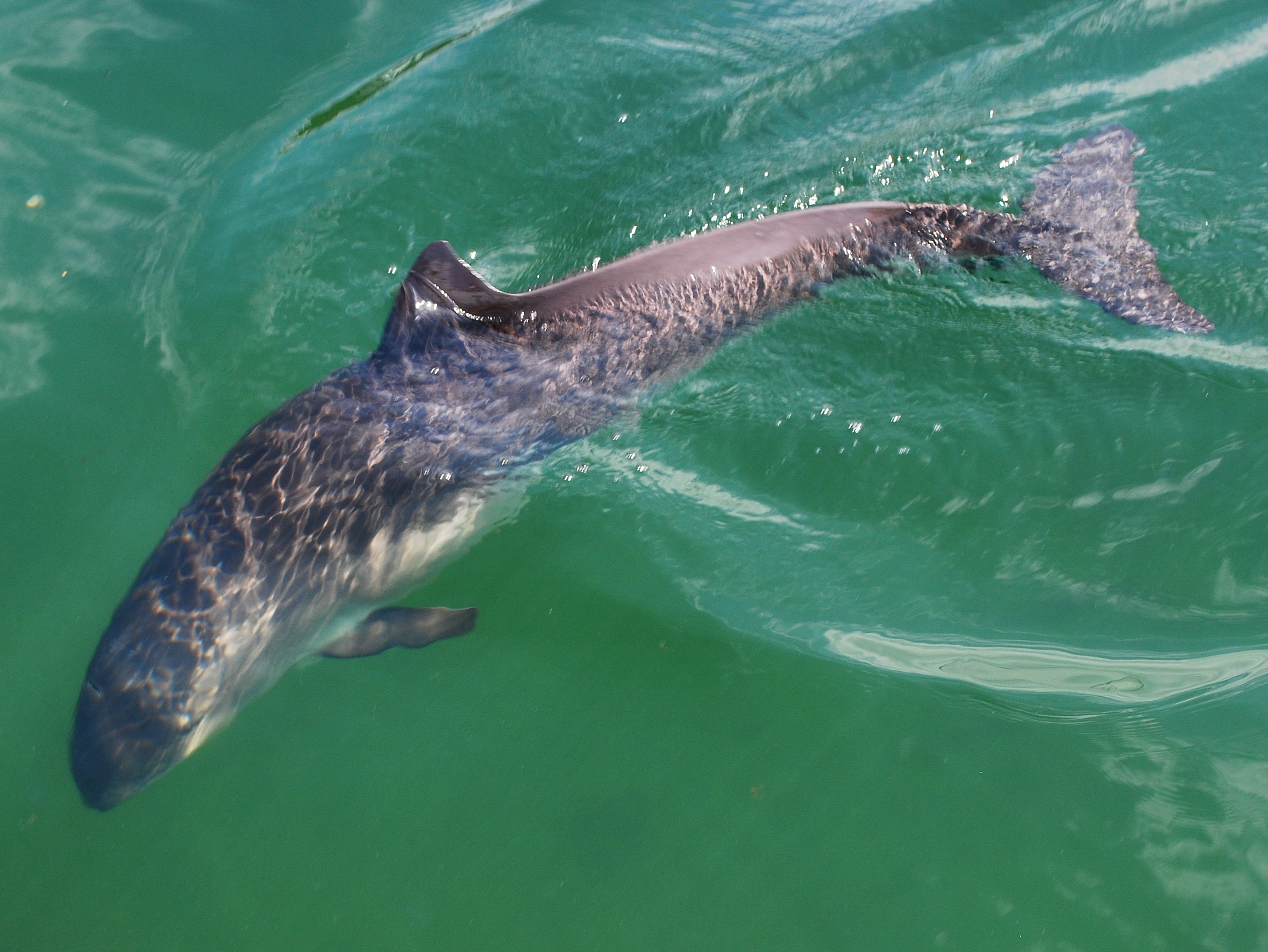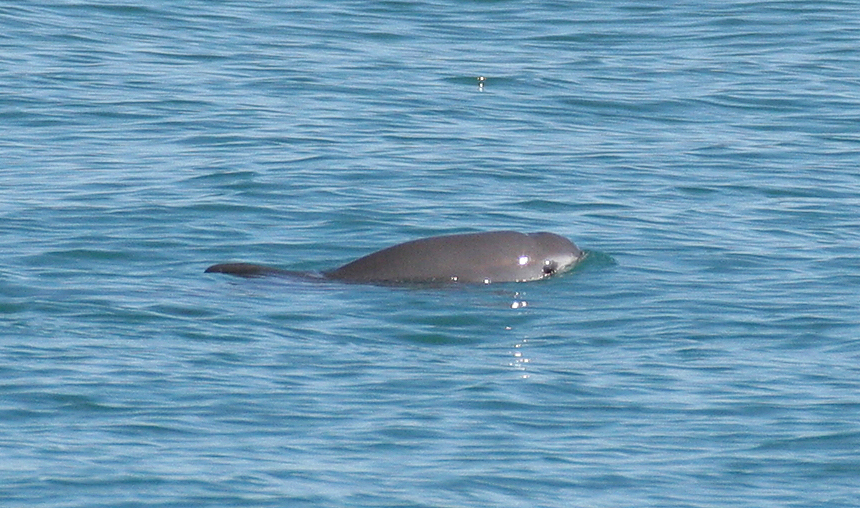|
Porpoise
Porpoises () are small Oceanic dolphin, dolphin-like cetaceans classified under the family Phocoenidae. Although similar in appearance to dolphins, they are more closely related to narwhals and Beluga whale, belugas than to the Oceanic dolphin, true dolphins. There are eight extant species of porpoise, all among the smallest of the toothed whales. Porpoises are distinguished from dolphins by their flattened, spade-shaped teeth distinct from the conical teeth of dolphins, and lack of a pronounced beak, although some dolphins (e.g. Hector's dolphin) also lack a pronounced beak. Porpoises, and other cetaceans, belong to the clade Cetartiodactyla with even-toed ungulates. Porpoises range in size from the vaquita, at in length and in weight, to the Dall's porpoise, at and . Several species exhibit sexual dimorphism in that the females are larger than males. They have streamlined bodies and two limbs that are modified into flippers. Porpoises use Animal echolocation, echolocatio ... [...More Info...] [...Related Items...] OR: [Wikipedia] [Google] [Baidu] |
Harbor Porpoise
The harbour porpoise (''Phocoena phocoena'') is one of eight extant species of porpoise. It is one of the smallest species of cetacean. As its name implies, it stays close to coastal areas or river estuaries, and as such, is the most familiar porpoise to whale-watching, whale watchers. This porpoise often ventures up rivers, and has been seen hundreds of kilometres from the sea. The harbour porpoise may be Polytypic taxon, polytypic, with geographically distinct populations representing distinct races: ''P. p. phocoena'' in the North Atlantic and West Africa, ''Black sea harbour porpoise, P. p. relicta'' in the Black Sea and Sea of Azov, an unnamed population in the northwestern Pacific and ''P. p. vomerina'' in the northeastern Pacific. Taxonomy The English word porpoise comes from the French (Old French , 12th century), which is from Medieval Latin , which is a compound of ''porcus'' (pig) and (fish). The old word is probably a loan-translation of a Germanic word, compare D ... [...More Info...] [...Related Items...] OR: [Wikipedia] [Google] [Baidu] |
Dall's Porpoise
Dall's porpoise (''Phocoenoides dalli'') is a species of porpoise endemic to the North Pacific. It is the largest of porpoises and the only member of the genus ''Phocoenoides''. The species is named after American naturalist William Healey Dall, W. H. Dall. Taxonomy Dall's porpoise is the only member of the genus ''Phocoenoides''. The ''dalli'' and ''truei'' types were initially described as separate species in 1911, but later studies determined that the available evidence only supported the existence of one species. Currently, these two color morphs are recognized as distinct subspecies, Dall's porpoise (''Phocoenoides dalli dalli'') and True's porpoise (''Phocoenoides dalli truei''). Description Dall's porpoises can be easily distinguished from other porpoises and cetacean species within their range. They have a wide, robust body, a comparatively tiny head, and no distinguished beak. Their flippers are positioned at the front of the body and a triangular dorsal fin sits mid- ... [...More Info...] [...Related Items...] OR: [Wikipedia] [Google] [Baidu] |
Cetacean
Cetacea (; , ) is an infraorder of aquatic mammals belonging to the order Artiodactyla that includes whales, dolphins and porpoises. Key characteristics are their fully aquatic lifestyle, streamlined body shape, often large size and exclusively carnivorous diet. They propel themselves through the water with powerful up-and-down movements of their tail, which ends in a paddle-like fluke, using their flipper-shaped forelimbs to steer. While the majority of cetaceans live in marine environments, a small number reside solely in brackish water, brackish or fresh water. Having a cosmopolitan distribution, they can be found in some rivers and all of Earth's oceans, and many species migrate throughout vast ranges with the changing of the seasons. Cetaceans are famous for cetacean intelligence, their high intelligence, complex social behaviour, and the enormous size of some of the group's members. For example, the blue whale reaches a maximum confirmed length of and a weight of 173 tonne ... [...More Info...] [...Related Items...] OR: [Wikipedia] [Google] [Baidu] |
Spectacled Porpoise
The spectacled porpoise (''Phocoena dioptrica'') is a small to midsize porpoise indigenous to the Southern Ocean. It is one of the most poorly studied cetaceans, partly due to its remote range in the Southern Ocean. What little is known about this porpoise species has been gathered mainly from stranded individuals, and a few observations of living animals made at sea. The species was first described in 1912 by Fernando Lahille. Description As with other porpoise species, the spectacled porpoise has no beak. It has small pectoral fins with rounded tips positioned far forward on the body, and a triangular dorsal fin. This porpoise species shows obvious sexual dimorphism between adult males and females, as the dorsal fins in males are much larger and more rounded than those of females. Records for female length range up to , while males may reach , which represents the largest specimen documented thus far. The maximum weight for a female was , while a male has been recorded a ... [...More Info...] [...Related Items...] OR: [Wikipedia] [Google] [Baidu] |
Vaquita
The vaquita ( ; ''Phocoena sinus'') is a species of porpoise endemic to the northern end of the Gulf of California in Baja California, Mexico. Reaching a maximum body length of (females) or (males), it is the smallest of all living cetaceans. The species is currently on the brink of extinction, and is listed as Critically Endangered by the IUCN Red List; the steep decline in abundance is primarily due to bycatch in gillnets from the illegal totoaba fishery. Taxonomy The vaquita was defined as a species by two zoologists, Kenneth S. Norris and William N. McFarland, in 1958 after studying the morphology of skull specimens found on the beach. It was not until nearly thirty years later, in 1985, that fresh specimens allowed scientists to describe their external appearance fully. The genus ''Phocoena'' comprises four species of porpoise, most of which inhabit coastal waters (the spectacled porpoise is more oceanic). The vaquita is most closely related to Burmeister's porpoi ... [...More Info...] [...Related Items...] OR: [Wikipedia] [Google] [Baidu] |
Finless Porpoise
''Neophocaena'' is a genus of porpoise native to the Indian and Pacific oceans, as well as the freshwater habitats of the Yangtze River basin in China China, officially the People's Republic of China (PRC), is a country in East Asia. With population of China, a population exceeding 1.4 billion, it is the list of countries by population (United Nations), second-most populous country after .... They are commonly known as finless porpoises. Genetic studies indicate that ''Neophocaena'' is the most basal living member of the porpoise family. There are three species in this genus: Description The finless porpoises are the only porpoises to lack a true dorsal fin. Instead there is a low ridge covered in thick skin bearing several lines of tiny tubercles. In addition, the forehead is unusually steep compared with those of other porpoises. With fifteen to twenty-one teeth in each jaw, they also have, on average, fewer teeth than other porpoises, although there is some o ... [...More Info...] [...Related Items...] OR: [Wikipedia] [Google] [Baidu] |
Toothed Whales
The toothed whales (also called odontocetes, systematic name Odontoceti) are a parvorder of cetaceans that includes dolphins, porpoises, and all other whales with teeth, such as beaked whales and the sperm whales. 73 species of toothed whales are described. They are one of two living groups of cetaceans, the other being the baleen whales (Mysticeti), which have baleen instead of teeth. The two groups are thought to have diverged around 34 million years ago (mya). Toothed whales range in size from the and vaquita to the and sperm whale. Several species of odontocetes exhibit sexual dimorphism, in that there are size or other morphological differences between females and males. They have streamlined bodies and two limbs that are modified into flippers. Some can travel at up to 30 knots. Odontocetes have conical teeth designed for catching fish or squid. They have well-developed hearing that is well adapted for both air and water, so much so that some can survive even if they ar ... [...More Info...] [...Related Items...] OR: [Wikipedia] [Google] [Baidu] |
Dolphin
A dolphin is an aquatic mammal in the cetacean clade Odontoceti (toothed whale). Dolphins belong to the families Delphinidae (the oceanic dolphins), Platanistidae (the Indian river dolphins), Iniidae (the New World river dolphins), Pontoporiidae (the brackish dolphins), and possibly extinct Lipotidae (baiji or Chinese river dolphin). There are 40 extant species named as dolphins. Dolphins range in size from the and Maui's dolphin to the and orca. Various species of dolphins exhibit sexual dimorphism where the males are larger than females. They have streamlined bodies and two limbs that are modified into flippers. Though not quite as flexible as Pinniped, seals, they are faster; some dolphins can briefly travel at speeds of or leap about . Dolphins use their conical teeth to capture fast-moving Predation, prey. They have well-developed hearing which is adapted for both air and water; it is so well developed that some can survive even if they are blind. Some species are w ... [...More Info...] [...Related Items...] OR: [Wikipedia] [Google] [Baidu] |
Oceanic Dolphin
Oceanic dolphins or Delphinidae are a widely distributed family of dolphins that live in the sea. Close to forty extant species are recognised. They include several big species whose common names contain "whale" rather than "dolphin", such as the Globicephalinae (round-headed whales, which include the false killer whale and pilot whale). Delphinidae is a family within the superfamily Delphinoidea, which also includes the porpoises (Phocoenidae) and the Monodontidae ( beluga whale and narwhal). River dolphins are relatives of the Delphinoidea. Oceanic dolphins range in size from the and Maui's dolphin to the and orca, the largest known dolphin. Several species exhibit sexual dimorphism; the males are larger than females. They have streamlined muscular bodies and two limbs that are modified into flippers. Though not quite as flexible as seals, some dolphins can travel at speeds 29 km/h (18 mph) for short distances. Most delphinids primarily eat fish, along wit ... [...More Info...] [...Related Items...] OR: [Wikipedia] [Google] [Baidu] |
Narwhal
The narwhal (''Monodon monoceros'') is a species of toothed whale native to the Arctic. It is the only member of the genus ''Monodon'' and one of two living representatives of the family Monodontidae. The narwhal is a stocky cetacean with a relatively blunt snout, a large Melon (whale), melon, and a shallow ridge in place of a dorsal fin. Males of this species have a large () long tusk, which is a protruding left Canine tooth, canine thought to function as a weapon, a tool for feeding, in sexual selection, attracting mates or sensing water salinity. Specially adapted slow-twitch muscles, along with the jointed neck vertebrae and shallow dorsal ridge allow for easy movement through the Arctic environment, where the narwhal spends extended periods at great depths. The narwhal's geographic range overlaps with that of the similarly built and closely related beluga whale, and the animals are known to interbreed. Narwhals inhabit the Arctic waters of Canada, Greenland and Russia. ... [...More Info...] [...Related Items...] OR: [Wikipedia] [Google] [Baidu] |








